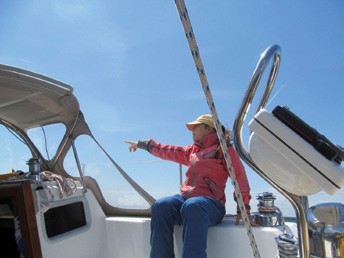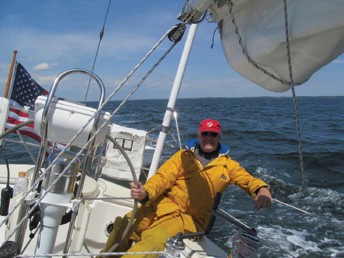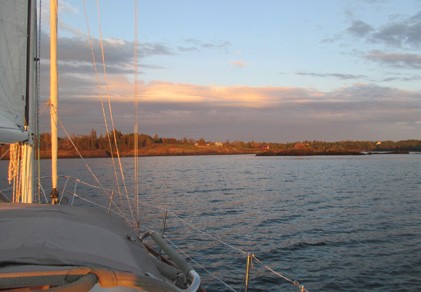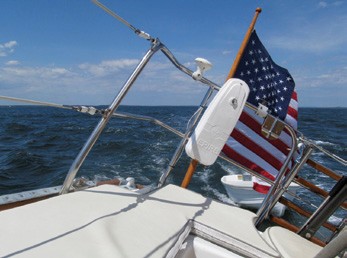By Molly Mulhern
 Not many folks were out and about cruising in Penobscot Bay over Memorial Day Weekend. With forecasts of air temperatures in the upper 40s and 40-knot gusts on Saturday, the impulse to stay home was certainly understandable. Still, the winter had been long and there Astraea sat on the mooring in Rockport on the Friday before Memorial Day weekend, so off we went on Friday afternoon between the fog and the showers to get aboard her.
Not many folks were out and about cruising in Penobscot Bay over Memorial Day Weekend. With forecasts of air temperatures in the upper 40s and 40-knot gusts on Saturday, the impulse to stay home was certainly understandable. Still, the winter had been long and there Astraea sat on the mooring in Rockport on the Friday before Memorial Day weekend, so off we went on Friday afternoon between the fog and the showers to get aboard her.
The author dusting off her piloting skills
We left the truck with all the gear and the dinghy at the dock as we hopped a ride out to the boat via one of the yard workers who helps put in boats, and there we were, aboard the J/34C that has been our summer cruising home for three-plus years now.
We purchased the boat in the middle of one summer season, renamed her before the next season, then last year had a two-week-only season due to work obligations in London. So this, our fourth season, we were anxious, hence the hopping aboard, waiting out one of last Friday’s many showers, loading her, and then heading out, with a magnificent double rainbow greeting us as I turned Astraea’s wheel to port at the Indian Island Light and headed off to the east. There was not another sailboat on the horizon, and that was to be the case for most of the next three days – Penobscot Bay pretty much to ourselves.
(Astraea, a boat name also used by one of our nautical heroes, Nathaniel Bowditch, means the virgin goddess of innocence and purity, and the name is also associated with the Greek goddess of justice. Renaming a boat, as we did, is a two-step process: first, the many months of searching for the appropriate new name, and second a renaming ceremony that includes offering a libation to Neptune over the bow, among other sailor-ly must-dos.)
 At ages 61 and 55 respectively, Jim, my partner, and I are not exactly young, nor are we totally new to sailing. Jim was thrown in the bilge of an A-Scow as a three year old and has never looked back to second guess his sailing heritage.
At ages 61 and 55 respectively, Jim, my partner, and I are not exactly young, nor are we totally new to sailing. Jim was thrown in the bilge of an A-Scow as a three year old and has never looked back to second guess his sailing heritage.
Jim at the helm of our J/34C – many layers and huge smiles
I, on the other hand, although sailing on other peoples’ boats for many years – including a six-year stint as a schooner cook on the Maine windjammers (do any of you remember the Roseway? I cooked on her for years under the tutelage of Andrea Young) – did not own my first real cruising boat until 10 years ago, so still consider myself a rank beginner. (There are so many things to learn about sailing I don’t expect to ever call myself anything but a beginner.)
I am always learning to sail and how to be a sailor. This trip the primary lesson was: it takes awhile to reclaim the boat and remember all the important stuff. Sailing is not so much like riding a bike, mostly because of the huge amount of technical knowledge and doing that goes with running a 34-foot boat. With a bike you’ve got the wheels, the brakes, and the derailer as key operating parts. On a sailboat on a cold day (45 degrees with a howling NW wind – that is, Force 8), there are many, many operating parts….and while we can readily remember the sail trim (maybe), after nine months with only a short season last year, remembering all the details like how the second reefing line is run, where to tie off the pole topping lift so it does not clang mercilessly in a evening gale on the mooring, or which combinations of prayers and solenoid switching turned on the propane-fired “Cozy Cabin Heater” (not so cozy on this trip for us, alas!) is not so easy. There are cobwebs to be dusted off.
 One major aspect to the sailing life that is dusted off is being weatherwise. It starts days before the trip, monitoring the NOAA offshore forecast online. The screen information is good, but you also begin to pay attention to the wind in the trees, and on the flagpoles, pondering if it is a slight ripple – Beaufort Force 2 – or if the flag is fully extended – a Beaufort Force 7 day.
One major aspect to the sailing life that is dusted off is being weatherwise. It starts days before the trip, monitoring the NOAA offshore forecast online. The screen information is good, but you also begin to pay attention to the wind in the trees, and on the flagpoles, pondering if it is a slight ripple – Beaufort Force 2 – or if the flag is fully extended – a Beaufort Force 7 day.
Approaching Pulpit Harbor, without the usual crush of boats on a late Friday afternoon.
Then aboard one has to remember how to tune the VHF to the weather (WX) forecast so that updates can be had while on the water. The more challenging part becomes one of living in the wind and weather…getting used to the howling in the rigging at night on the mooring, remembering how many layers of fleece are needed under the foul weather gear, getting accustomed, if one ever were, to sailing on edge.
I remember reading someplace that sailing before the summer solstice and after the autumnal equinox in our corner of Maine was when you’d find wind, and this weekend was not a disappointment. Some sailors relish the kind of wind we saw out there. Only for me, as a newbie, I am still scared to death when the boat heels over, thinking an imminent tip is in the cards. Now, I do know better, understanding intellectually, anyway, that some angle of heel is required in a monohull. But I also know that reefing – shortening sail – is another way to deal with this heeling, and I insist upon it, nearly every time the wind threatens to blow above 17 knots (Force 5). (And much to Jim’s credit, he knows that burying the rail with too much sail aloft not only does nothing to improve speed, but also has negative affects in interpersonal dynamics once arriving at the mooring after such excessive displays of bravado and imprudent risk of expensive hardware…) And reefing makes a huge difference. The boat sails a little flatter, hence I am a bit more comfortable going to windward. And as we experienced this weekend, reefing does little to hurt our boatspeed, as we hit 7.5 to 8 knots several times on Sunday, and more so on Monday, as we were sailing more off the wind and had the benefit of the planing to add to our speed.
 In addition to the cold air temps and the high windspeeds, the other challenge of Memorial Day weekend sailing is the hypothermia-inducing water temperatures. At 50 degrees F or less, there are many reasons to make sure a sailor stays out of the water at this time of the year. Do you remember the tragic drowning of a doctor in Rockport Harbor seven years ago on Memorial Day weekend? The trauma surgeon and his buddy were rowing their dinghy out to their sailboat, eager to hop aboard for a weekend sail. Something went awry on the row, and somehow the dinghy became unstable and they both went into the harbor. Minutes are all that are between you and death. So, take precautions – wear the PFD, have your submersible VHF in your PFD pocket, and for God’s sakes (and the sakes of all your loved ones, and you) stay in the boat.
In addition to the cold air temps and the high windspeeds, the other challenge of Memorial Day weekend sailing is the hypothermia-inducing water temperatures. At 50 degrees F or less, there are many reasons to make sure a sailor stays out of the water at this time of the year. Do you remember the tragic drowning of a doctor in Rockport Harbor seven years ago on Memorial Day weekend? The trauma surgeon and his buddy were rowing their dinghy out to their sailboat, eager to hop aboard for a weekend sail. Something went awry on the row, and somehow the dinghy became unstable and they both went into the harbor. Minutes are all that are between you and death. So, take precautions – wear the PFD, have your submersible VHF in your PFD pocket, and for God’s sakes (and the sakes of all your loved ones, and you) stay in the boat.
Are there compensations for dusting off the cobwebs early and getting out there early in the season, or according to some, before the sailing season? Indeed. Having East Penobscot Bay to ourselves on Sunday, with the exception of a small tacking duel with the schooner Stephen Taber at the eastern end of the Fox Island thoroughfare, watching an incredible sunset over the Camden Hills on Friday night with no other sailboats at Pulpit (unheard of!), and finally, jumpstarting the learning process so next weekend won’t be so full of oops and fits and starts. Not to mention choice anchoring in just about any cove on the Bay.
Molly Mulhern is a nautical publisher, editor, writer, and champion of all things book- and sailing-related. As past editorial director at International Marine, Molly’s aim has always been to publish books that improve the quality of life for sailors and outdoorspeople, helping them achieve their dreams. She is now consulting and acquiring books for a New York trade publisher. Molly sails and races her Tanzer 22 Ripple out of Rockland, and her J/34C Astraea out of Camden, Maine. Molly is helping the Rockland Yacht Club set up a sailing mentor exchange, volunteering her services as Women’s Sailing Mentor.



